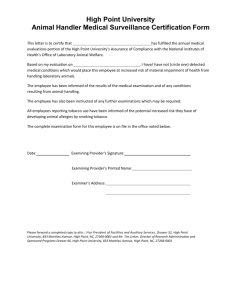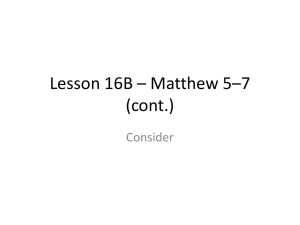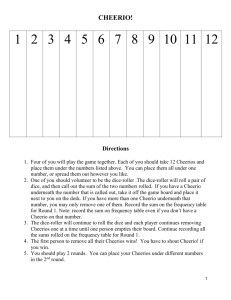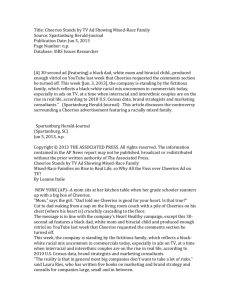Supplemental Digital Content for: Stanzione, C., & Schick, B. (2014
advertisement
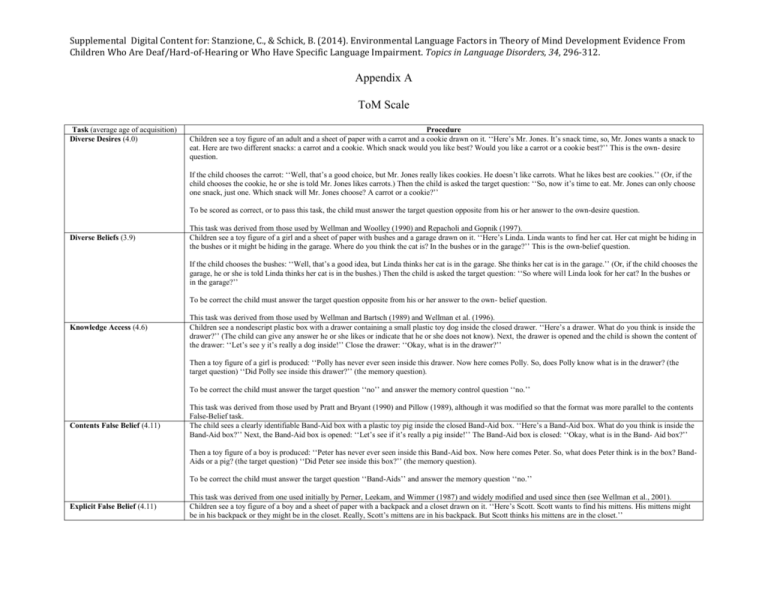
Supplemental Digital Content for: Stanzione, C., & Schick, B. (2014). Environmental Language Factors in Theory of Mind Development Evidence From Children Who Are Deaf/Hard-of-Hearing or Who Have Specific Language Impairment. Topics in Language Disorders, 34, 296-312. Appendix A ToM Scale Task (average age of acquisition) Diverse Desires (4.0) Procedure Children see a toy figure of an adult and a sheet of paper with a carrot and a cookie drawn on it. ‘‘Here’s Mr. Jones. It’s snack time, so, Mr. Jones wants a snack to eat. Here are two different snacks: a carrot and a cookie. Which snack would you like best? Would you like a carrot or a cookie best?’’ This is the own- desire question. If the child chooses the carrot: ‘‘Well, that’s a good choice, but Mr. Jones really likes cookies. He doesn’t like carrots. What he likes best are cookies.’’ (Or, if the child chooses the cookie, he or she is told Mr. Jones likes carrots.) Then the child is asked the target question: ‘‘So, now it’s time to eat. Mr. Jones can only choose one snack, just one. Which snack will Mr. Jones choose? A carrot or a cookie?’’ To be scored as correct, or to pass this task, the child must answer the target question opposite from his or her answer to the own-desire question. Diverse Beliefs (3.9) This task was derived from those used by Wellman and Woolley (1990) and Repacholi and Gopnik (1997). Children see a toy figure of a girl and a sheet of paper with bushes and a garage drawn on it. ‘‘Here’s Linda. Linda wants to find her cat. Her cat might be hiding in the bushes or it might be hiding in the garage. Where do you think the cat is? In the bushes or in the garage?’’ This is the own-belief question. If the child chooses the bushes: ‘‘Well, that’s a good idea, but Linda thinks her cat is in the garage. She thinks her cat is in the garage.’’ (Or, if the child chooses the garage, he or she is told Linda thinks her cat is in the bushes.) Then the child is asked the target question: ‘‘So where will Linda look for her cat? In the bushes or in the garage?’’ To be correct the child must answer the target question opposite from his or her answer to the own- belief question. Knowledge Access (4.6) This task was derived from those used by Wellman and Bartsch (1989) and Wellman et al. (1996). Children see a nondescript plastic box with a drawer containing a small plastic toy dog inside the closed drawer. ‘‘Here’s a drawer. What do you think is inside the drawer?’’ (The child can give any answer he or she likes or indicate that he or she does not know). Next, the drawer is opened and the child is shown the content of the drawer: ‘‘Let’s see y it’s really a dog inside!’’ Close the drawer: ‘‘Okay, what is in the drawer?’’ Then a toy figure of a girl is produced: ‘‘Polly has never ever seen inside this drawer. Now here comes Polly. So, does Polly know what is in the drawer? (the target question) ‘‘Did Polly see inside this drawer?’’ (the memory question). To be correct the child must answer the target question ‘‘no’’ and answer the memory control question ‘‘no.’’ Contents False Belief (4.11) This task was derived from those used by Pratt and Bryant (1990) and Pillow (1989), although it was modified so that the format was more parallel to the contents False-Belief task. The child sees a clearly identifiable Band-Aid box with a plastic toy pig inside the closed Band-Aid box. ‘‘Here’s a Band-Aid box. What do you think is inside the Band-Aid box?’’ Next, the Band-Aid box is opened: ‘‘Let’s see if it’s really a pig inside!’’ The Band-Aid box is closed: ‘‘Okay, what is in the Band- Aid box?’’ Then a toy figure of a boy is produced: ‘‘Peter has never ever seen inside this Band-Aid box. Now here comes Peter. So, what does Peter think is in the box? BandAids or a pig? (the target question) ‘‘Did Peter see inside this box?’’ (the memory question). To be correct the child must answer the target question ‘‘Band-Aids’’ and answer the memory question ‘‘no.’’ Explicit False Belief (4.11) This task was derived from one used initially by Perner, Leekam, and Wimmer (1987) and widely modified and used since then (see Wellman et al., 2001). Children see a toy figure of a boy and a sheet of paper with a backpack and a closet drawn on it. ‘‘Here’s Scott. Scott wants to find his mittens. His mittens might be in his backpack or they might be in the closet. Really, Scott’s mittens are in his backpack. But Scott thinks his mittens are in the closet.’’ Supplemental Digital Content for: Stanzione, C., & Schick, B. (2014). Environmental Language Factors in Theory of Mind Development Evidence From Children Who Are Deaf/Hard-of-Hearing or Who Have Specific Language Impairment. Topics in Language Disorders, 34, 296-312. ‘‘So, where will Scott look for his mittens? In his backpack or in the closet?’’ (the target question) ‘‘Where are Scott’s mittens really? In his backpack or in the closet?’’ (the reality question). To be correct the child must answer the target question ‘‘closet’’ and answer the reality question ‘‘backpack.’’ Belief – Emotion (5.4) This task was derived from one used by Wellman and Bartsch (1989) and Siegal and Beattie (1991). Children see a toy figure of a boy and a clearly identifiable individual-size Cheerios box with rocks inside the closed box. ‘‘Here is a Cheerios box and here is Teddy. What do you think is inside the Cheerios box?’’ (Cheerios) Then the adult makes Teddy speak: ‘‘Teddy says, ‘Oh good, because I love Cheerios. Cheerios are my favorite snack. Now I’ll go play.’’’ Teddy is then put away and out of sight. Next, the Cheerios box is opened and the contents are shown to the child: ‘‘Let’s see… there are really rocks inside and no Cheerios! There’s nothing but rocks.’’ The Cheerios box is closed: ‘‘Okay, what is Teddy’s favorite snack?’’ (Cheerios). Then Teddy comes back: ‘‘Teddy has never ever seen inside this box. Now here comes Teddy. Teddy’s back and it’s snack time. Let’s give Teddy this box. So, how does Teddy feel when he gets this box? Happy or sad?’’ (the target question) The adult opens the Cheerios box and lets the toy figure look inside: ‘‘How does Teddy feel after he looks inside the box? Happy or sad?’’ (the emotion-control question). To be correct, the child must answer the target question ‘‘happy’’ and answer the emotion-control question ‘‘sad.’’ Real – Apparent Emotion (5.4) This task was derived from one used by Harris, Johnson, Hutton, Andrews, and Cooke (1989). Initially, children see a sheet of paper with three faces drawn on it: a happy, a neutral, and a sad face, to check that the child knows these emotional expressions. Then that paper is put aside, and the task begins with the child being shown a cardboard cutout figure of a boy drawn from the back so that the boy’s facial expression cannot be seen. ‘‘This story is about a boy. I’m going to ask you about how the boy really feels inside and how he looks on his face. He might really feel one way inside but look a different way on his face. Or, he might really feel the same way inside as he looks on his face. I want you to tell me how he really feels inside and how he looks on his face.’’ ‘‘This story is about Matt. Matt’s friends were playing together and telling jokes. One of the older children, Rosie, told a mean joke about Matt and everyone laughed. Everyone thought it was very funny, but not Matt. But, Matt didn’t want the other children to see how he felt about the joke, because they would call him a baby. So, Matt tried to hide how he felt.’’ Then the child gets two memory checks: ‘‘What did the other children do when Rosie told a mean joke about Matt?’’ (Laughed or thought it was funny.) ‘‘In the story, what would the other children do if they knew how Matt felt?’’ (Call Matt a baby or tease him.) Pointing to the three emotion pictures: ‘‘So, how did Matt really feel, when everyone laughed? Did he feel happy, sad, or okay?’’ (the target-feel question) ‘‘How did Matt try to look on his face, when everyone laughed? Did he look happy, sad, or okay? (the target-look question). To be correct the child’s answer to the target-feel question must be more negative than his or her answer to the target-look question (i.e., sad for target- feel and happy or okay for target-look, or okay for target-feel and happy for target-look). This task was derived from one used by Harris, Donnelly, Guz, and Pitt-Watson (1986). Supplemental Digital Content for: Stanzione, C., & Schick, B. (2014). Environmental Language Factors in Theory of Mind Development Evidence From Children Who Are Deaf/Hard-of-Hearing or Who Have Specific Language Impairment. Topics in Language Disorders, 34, 296-312. Appendix B Examples of Mental State Terms in English Think, know, pretend, guess, remember, guess, mean, forget, wish, figure, believe, dream, bet, understand, hope, suppose, trick, wonder, learn, real, reason, doubt, lie, secret, confuse, have in mind, curious, surprise, idea, make believe, realize
